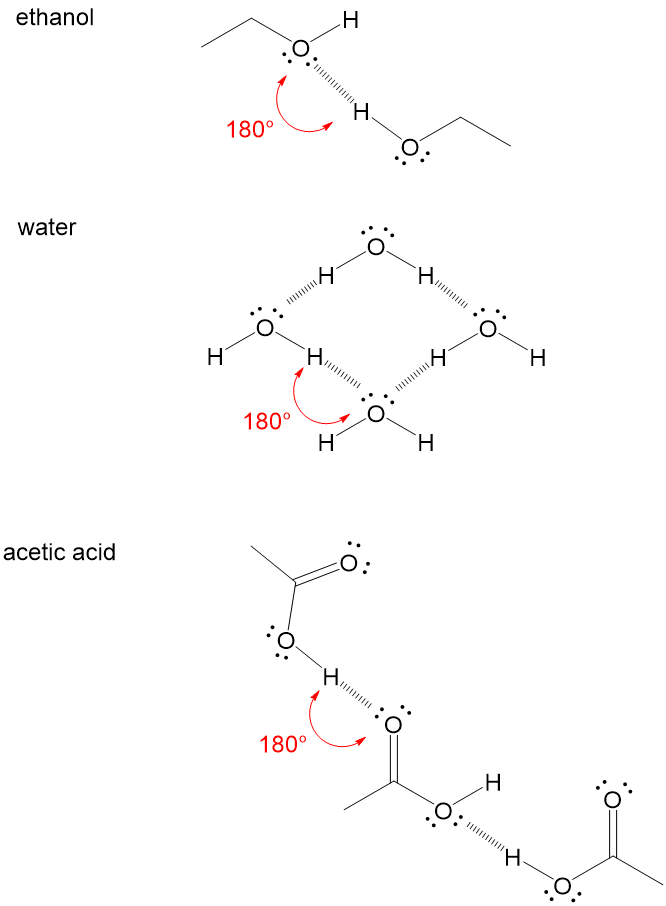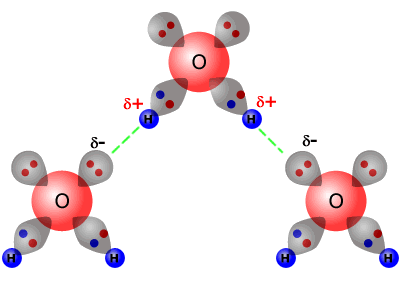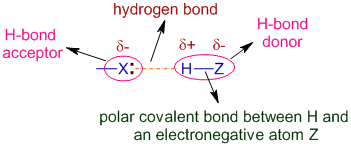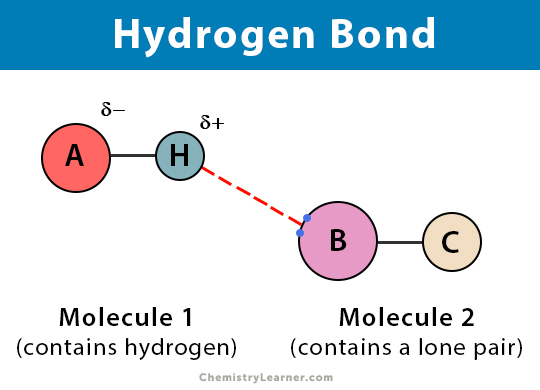Which of the following atoms can attract a hydrogen atom in a hydrogen bond.
If you’re looking for which of the following atoms can attract a hydrogen atom in a hydrogen bond images information linked to the which of the following atoms can attract a hydrogen atom in a hydrogen bond topic, you have pay a visit to the right blog. Our website always gives you hints for downloading the highest quality video and image content, please kindly surf and find more informative video articles and graphics that fit your interests.
 Hydrogen Bonding Chemistry For Non Majors From courses.lumenlearning.com
Hydrogen Bonding Chemistry For Non Majors From courses.lumenlearning.com
These can then attract one another and create substances with higher boiling points. Also the oxygen which has two lone pairs of electrons can form two hydrogen bonds with hydrogen atoms. The hydrogen atoms are bound to the highly electronegative oxygen atom which also possesses two lone pair sets of electrons making for a very polar bond. The bond between Na and Cl in salt e.
The only way these atoms can get closer to one another is if.
The first way gives rise to what is called an ionic bond. For example several H-F molecules are associated by hydrogen bond s as. Once the way atoms are put together is understood the question of how they interact with each other can be addressedin particular how they form bonds to create molecules and macroscopic materials. The elements that usually participate in hydrogen bonds are nitrogen oxygen and fluorine. A hydrogen atom and an oxygen atom.
 Source: pinterest.com
Source: pinterest.com
Answer 1 of 13. Atom - atom - Atomic bonds. 12Å for hydrogen and 15Å for oxygen and nitrogen. Water shown above is a molecule which can exhibit hydrogen bonding. This sums to four hydrogen bonds per water molecule.
The elements that usually participate in hydrogen bonds are nitrogen oxygen and fluorine.
Also the oxygen which has two lone pairs of electrons can form two hydrogen bonds with hydrogen atoms. In the picture of two water molecules at lower right the oxygen of the water molecule B is the hydrogen bond donor. A hydrogen bond is a primarily electrostatic force of attraction between a hydrogen atom which is covalently bound to a more electronegative atom or group and another electronegative atom bearing a lone pair of electronsthe hydrogen bond acceptor. Hydrogen bond acceptor and the hydrogen itself can be as short as 18-19 Å well below the sum of the atomic radii eg.
 Source: studyorgo.com
Source: studyorgo.com
These can then attract one another and create substances with higher boiling points. In other words hydrogen bonding occ. A hydrogen bond can form between_____ adjacent to each other. The bond between Na and Cl in salt e.
 Source: in.pinterest.com
Source: in.pinterest.com
You know that the Lennard-Jones potential rises with 1r12 if we get closer than the Van der Vaals radii. So hydrogen bonding is possible only in those compounds in which the hydrogen atom is directly bonded to fluorine oxygen or nitrogen. The elements that usually participate in hydrogen bonds are nitrogen oxygen and fluorine. It results fromthe attractive force between a hydrogen atom covalently bonded toa very electronegative atom such as a N O or F atom and another veryelectronegative atom.
 Source: pinterest.com
Source: pinterest.com
For example several H-F molecules are associated by hydrogen bond s as. The hydrogen atoms are bound to the highly electronegative oxygen atom which also possesses two lone pair sets of electrons making for a very polar bond. A hydrogen atoms form an ionic bond with another atom on an adjacent molecule. Due to the large electronegativity difference strong dipoles are created on either end of the molecule as shown below.
The bond between the H of one water molecule and the O of another water molecule b. You know that the Lennard-Jones potential rises with 1r12 if we get closer than the Van der Vaals radii. Which of the following is an example of a hydrogen bond. Due to the large electronegativity difference strong dipoles are created on either end of the molecule as shown below.
In molecules containing N-H O-H or F-H bonds the large difference inelectronegativity between the H atom and the N O or F atom leads to ahighly polar.
Hydrogen bond strengths range from 4 kJ to50 kJ per mole of hydrogen bonds. The hydrogen atoms are bound to the highly electronegative oxygen atom which also possesses two lone pair sets of electrons making for a very polar bond. In the picture of two water molecules at lower right the oxygen of the water molecule B is the hydrogen bond donor. A hydrogen atoms form an ionic bond with another atom on an adjacent molecule. 12Å for hydrogen and 15Å for oxygen and nitrogen.

As these three atoms are the only ones with sufficient electronegativity that when bound to hydrogen can form hydrogen bonds. For example several H-F molecules are associated by hydrogen bond s as. The bond between the H of one water molecule and the O of another water molecule b. A hydrogen atom forms a covalent bond with another atom. You know that the Lennard-Jones potential rises with 1r12 if we get closer than the Van der Vaals radii.
In molecules containing N-H O-H or F-H bonds the large difference inelectronegativity between the H atom and the N O or F atom leads to ahighly polar. Hydrogen bond strengths range from 4 kJ to50 kJ per mole of hydrogen bonds. 12Å for hydrogen and 15Å for oxygen and nitrogen. There are three basic ways that the outer electrons of atoms can form bonds.
The bond between Mg and Cl in MgCl2 c.
Hydrogen bond is formed only by the three highly electronegative elements- fluorine oxygen and nitrogen. The bond between two hydrogen atoms d. The nitrogen atom is called the hydrogen bond acceptor because it is accepting the hydrogen from the oxygen. The first way gives rise to what is called an ionic bond.

So hydrogen bonding is possible only in those compounds in which the hydrogen atom is directly bonded to fluorine oxygen or nitrogen. Atom - atom - Atomic bonds. The bond between the H of one water molecule and the O of another water molecule b. It results fromthe attractive force between a hydrogen atom covalently bonded toa very electronegative atom such as a N O or F atom and another veryelectronegative atom.
 Source: ibchem.com
Source: ibchem.com
The bond between C. A hydrogen atom and an oxygen atom. Also the oxygen which has two lone pairs of electrons can form two hydrogen bonds with hydrogen atoms. The attractive force which binds hydrogen atom of one molecule with electronegative atom such as fluorine oxygen and nitrogen of another molecule generally of the same substance is known as hydrogen bond.
 Source: toppr.com
Source: toppr.com
The hydrogen atoms are bound to the highly electronegative oxygen atom which also possesses two lone pair sets of electrons making for a very polar bond. A hydrogen atom in a molecule forms a bond with any atom. Hydrogen bond acceptor and the hydrogen itself can be as short as 18-19 Å well below the sum of the atomic radii eg. 12Å for hydrogen and 15Å for oxygen and nitrogen.
The hydrogen atoms are bound to the highly electronegative oxygen atom which also possesses two lone pair sets of electrons making for a very polar bond.
There are three basic ways that the outer electrons of atoms can form bonds. The elements that usually participate in hydrogen bonds are nitrogen oxygen and fluorine. In other words hydrogen bonding occ. The only way these atoms can get closer to one another is if. You know that the Lennard-Jones potential rises with 1r12 if we get closer than the Van der Vaals radii.

The partially positive hydrogen atom of one molecule is then attracted to the oxygen atom of a nearby water molecule see Figure below. These can then attract one another and create substances with higher boiling points. In the picture of two water molecules at lower right the oxygen of the water molecule B is the hydrogen bond donor. A hydrogen atom in a molecule forms a bond with any atom. The bond between the H of one water molecule and the O of another water molecule b.
In the picture of two water molecules at lower right the oxygen of the water molecule B is the hydrogen bond donor.
Two hydrogen atoms b. A hydrogen atom forms a covalent bond with another atom. Hydrogen bond is formed only by the three highly electronegative elements- fluorine oxygen and nitrogen. Answer 1 of 13.
 Source: pinterest.com
Source: pinterest.com
The bond between two hydrogen atoms d. The bond between C. The partially positive hydrogen atom of one molecule is then attracted to the oxygen atom of a nearby water molecule see Figure below. In the picture of two water molecules at lower right the oxygen of the water molecule B is the hydrogen bond donor.
 Source: adichemistry.com
Source: adichemistry.com
A hydrogen atom and an oxygen atom. There are three basic ways that the outer electrons of atoms can form bonds. Once the way atoms are put together is understood the question of how they interact with each other can be addressedin particular how they form bonds to create molecules and macroscopic materials. The bond between C.

The elements that usually participate in hydrogen bonds are nitrogen oxygen and fluorine. A hydrogen atom bonded to F O or N is attracted to an electron pair. Hydrogen bond strengths range from 4 kJ to50 kJ per mole of hydrogen bonds. Which of the following is an example of a hydrogen bond.
Two hydrogen atoms b.
Due to the large electronegativity difference strong dipoles are created on either end of the molecule as shown below. The bond between C. In the picture of two water molecules at lower right the oxygen of the water molecule B is the hydrogen bond donor. A hydrogen bond can form between_____ adjacent to each other. Once the way atoms are put together is understood the question of how they interact with each other can be addressedin particular how they form bonds to create molecules and macroscopic materials.

Atom - atom - Atomic bonds. Such an interacting system is generally denoted DnHAc where the solid line denotes a polar covalent bond and the dotted or dashed line. The elements that usually participate in hydrogen bonds are nitrogen oxygen and fluorine. Also the oxygen which has two lone pairs of electrons can form two hydrogen bonds with hydrogen atoms. 12Å for hydrogen and 15Å for oxygen and nitrogen.
Due to the large electronegativity difference strong dipoles are created on either end of the molecule as shown below.
There are three basic ways that the outer electrons of atoms can form bonds. In other words hydrogen bonding occ. There are three basic ways that the outer electrons of atoms can form bonds. In molecules containing N-H O-H or F-H bonds the large difference inelectronegativity between the H atom and the N O or F atom leads to ahighly polar.
 Source: chemistrylearner.com
Source: chemistrylearner.com
The partially positive hydrogen atom of one molecule is then attracted to the oxygen atom of a nearby water molecule see Figure below. Such an interacting system is generally denoted DnHAc where the solid line denotes a polar covalent bond and the dotted or dashed line. You know that the Lennard-Jones potential rises with 1r12 if we get closer than the Van der Vaals radii. A hydrogen bond is a primarily electrostatic force of attraction between a hydrogen atom which is covalently bound to a more electronegative atom or group and another electronegative atom bearing a lone pair of electronsthe hydrogen bond acceptor. These can then attract one another and create substances with higher boiling points.
 Source: pinterest.com
Source: pinterest.com
The hydrogen atoms are bound to the highly electronegative oxygen atom which also possesses two lone pair sets of electrons making for a very polar bond. The bond between Na and Cl in salt e. A hydrogen atoms form an ionic bond with another atom on an adjacent molecule. The only way these atoms can get closer to one another is if. Atom - atom - Atomic bonds.
 Source: pinterest.com
Source: pinterest.com
This sums to four hydrogen bonds per water molecule. The bond between two hydrogen atoms d. A hydrogen atom bonded to F O or N is attracted to an electron pair. It results fromthe attractive force between a hydrogen atom covalently bonded toa very electronegative atom such as a N O or F atom and another veryelectronegative atom. A hydrogen atoms form an ionic bond with another atom on an adjacent molecule.
This site is an open community for users to submit their favorite wallpapers on the internet, all images or pictures in this website are for personal wallpaper use only, it is stricly prohibited to use this wallpaper for commercial purposes, if you are the author and find this image is shared without your permission, please kindly raise a DMCA report to Us.
If you find this site helpful, please support us by sharing this posts to your preference social media accounts like Facebook, Instagram and so on or you can also bookmark this blog page with the title which of the following atoms can attract a hydrogen atom in a hydrogen bond by using Ctrl + D for devices a laptop with a Windows operating system or Command + D for laptops with an Apple operating system. If you use a smartphone, you can also use the drawer menu of the browser you are using. Whether it’s a Windows, Mac, iOS or Android operating system, you will still be able to bookmark this website.





